|
|
 |
| |
Home > Chapter VIII
|
|
Chap VIII. Energy resources
|
Introduction
|
Rwanda has considerable opportunities for energy development – from hydro sources, methane gas, solar and peat deposits. Untapped resources for power generation amount to about 1,200 MW. Most of these energy sources have not been fully exploited. As such, wood is still the major source of energy for 94 per cent of the population and imported petroleum products consume more than 40 per cent of foreign exchange.
Energy is a key component of the economy. It is thus recognised that the current inadequate and expensive energy supply constitutes a limiting factor to sustainable development. Rwanda’s Vision 2020 emphasizes the need for economic growth, private investment and economic transformation supported by a reliable and affordable energy supply as a key factor for the development process. To achieve this transformation, the country will need to increase energy production and diversify into alternative energy sources.
The Vision 2020 energy target is to have at least 35 per cent of the population connected to electricity (up from the current 6 per cent) and to reduce the rate of wood use in national energy consumption from the current 94 to 50 per cent (ROR 2000). Additionally, the PRSP aims to ensure a energy consumption growth rate of nearly 10 per cent per year, and a rural electrification rate of 30 per cent giving electricity access to 35 per cent of the population by 2020 (ROR 2007).
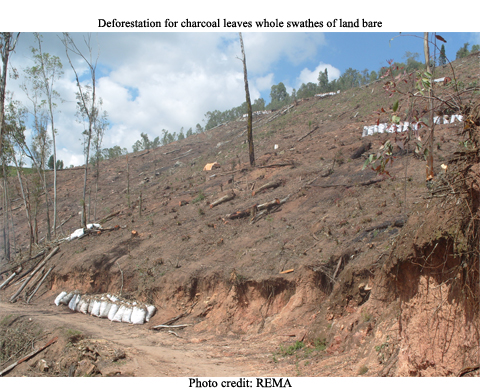
|
The energy crisis in Rwanda
|
Several indicators point to an energy crisis in Rwanda including: accelerated deforestation, a biomass energy deficit and deterioration in electricity generation and distribution systems.
The major part of the energy consumed in Rwanda today still comes from wood (80.4 per cent). Yet studies carried out as far back as 1981/82 and 1989/90 already showed a gap of 3,000,000 m³ of wood for energy needs only (Privatisation Secretariat undated). As a result, there is massive deforestation across the country with consequent effects on the environment. Deforestation is discussed in greater detail in Chapter 6: Forests and Protected Areas.
The installed electricity generation capacity is extremely low at 72.445 MW from all categories (MININFRA 2009a). Only 2 per cent of the population has access to electricity, and there is a gap in national production of electricity of more than 50 per cent which is filled by electricity imported from the Democratic Republic of Congo and Uganda (Privatisation Secretariat undated). Figure 1 shows the energy demand by sector, while table 1 shows the current electricity generating capacity in the country.

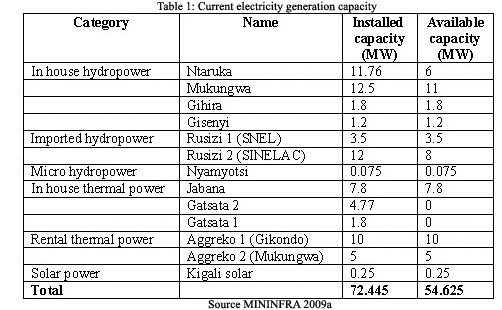
|
Sources of energy in Rwanda
|
The energy sector in Rwanda is made up of three sub-sectors: power, hydrocarbon and new and renewable sources of energy. Amongst the renewable sources of energy are biomass, solar, peat, wind, geothermal and hydropower. Biomass is the most used and dominates both the demand and supply sides of the Rwandan economy. The current national energy balance of 86, 11 and 3 per cent of all energy consumed is used in the form of biomass, hydrocarbons and electricity, respectively. This is shown in figure 2.

Biomass or primary energy balance
Biomass is used in the form of firewood, charcoal or agricultural residues mainly for cooking purposes in Rwandan households, and also in some industries (MININFRA 2008a). In the rural areas, biomass meets up to 94 per cent of national needs; with the balance being met by other options such as kerosene, diesel, dry cells, grid and non-grid electricity, biogas, solar, wind and other renewable energies. Biomass is already in short supply with the country facing a biomass deficit of over 4 million m3 per year.
Although fuel wood consumption is expected to increase in the short-term, the long-term strategy of the EDPRS is to reduce fuel wood consumption from 94 to 50 per cent by the end of 2020. Table 2 indicates an expected increase in consumption by 20 per cent between 2005 and 2010. Measures to address this include a plan to increase the area under forest from 20 to 23.5 per cent by 2012. This will be accompanied by a concurrent decrease in wood consumption from 8.9 to 6.2 million m3.
Rwanda is expected to continue using firewood which will be capped at 25 per cent for Kigali, 40 per cent for other urban areas and 90 per cent for rural areas and be suppressed progressively with the introduction of LPG and other alternatives including solar and thermal applications. However due to uncertainty in introduction of LPG and solar thermal applications, the high levels of production for Improved Cooking Stoves will be maintained and the market influenced to evolve with the entry of the new fuels and technologies. The East African Community Scaling-Up strategy is to undertake a serious campaign to introduce Improvised Cook Stoves (ICS) on a sustained business model to keep the supply and demand balanced. The firewood ICS are cheaper than the charcoal ICS at US $3 compared to US $6 respectively.
Impacts of biomass use on the economy and environment
Studies indicate that about 80 per cent of firewood used in the country is foraged (no cost for end users) and very little goes through the market economy (Theuri 2007). This has implications for providing alterative interventions and is likely to hamper efforts towards development of environmental friendly alternatives. But there are also implications on time spent in collecting this fuel. Theuri (2007) estimates that households in Kigali spend the shortest time to access wood fuel, about half an hour; while other urban and rural spend about one and half hours and 2 hours respectively.
The continued lack of alternative energy sources such as LPG or electricity are leading to increased pressure on the available forest resources for firewood and charcoal. Charcoal is the preferred fuel for urban households and demand is pushing up the price. In 2003, the charcoal market had a turnover of US $30 million (World Bank 2006). The current trend towards increased urbanization and the declining state of forest resources points to the need to design effective policies to address some of the pressing challenges in the energy sector.
table 2
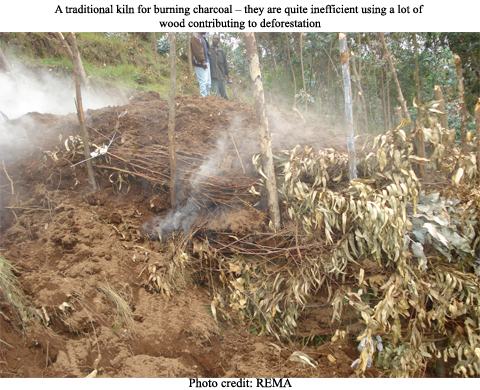
The power sub-sector
ELECTROGAZ has been the sole integrated electricity supplier in the country. Rwanda imports electricity through cross-border interconnections of about 15.5 MW from the DRC and SINELAC and about 3MW from Uganda (MININFRA 2009a). Figure 3 shows the electricity distribution network in the country. Electricity is imported from Ruzizi I (a power plant belonging to DRC), Ruzizi II (a community power plant belonging to Rwanda, Burundi and the DRC) and from Uganda. In spite of these imports, there is a gap in electricity generation of about 50 per cent. By 2004 this amounted to about 380 MWh of electricity supplied (UNDP 2007). Figure 4 shows the electricity demand and supply by Electrogaz in 2004 and table 3 shows the electricity balance for Rwanda.
Electricity shortage has necessitated regular load shedding. Load shedding is when power distribution companies switch off electricity supply to some clients. Frequent power shortage has resulted in individuals, manufacturing entities and firms purchasing their own generators. This has led to an increase in production costs of industry, a subsequent increase in consumer goods and increased emissions to the environment. Power shortages have also led to a 250 per cent increase in power prices – from 48 to 120 Rwf per unit of power (UNDP 2007). At the times of this energy crisis, there was also a shortage of charcoal. Most of the shortage is caused by deforestation due to exploitation of forests for biomass energy.
In order to meet demand Electrogaz purchased a number of diesel powered generators. By the second quarter of 2006 the cost of paying for the diesel was estimated to approximately US $65,000 per day. Although electricity is consumed mainly in urban areas, there are cost implications of these expenditures to the rest of the economy. Kigali alone consumes about 60 per cent of the entire generated electricity (UNDP 2007).


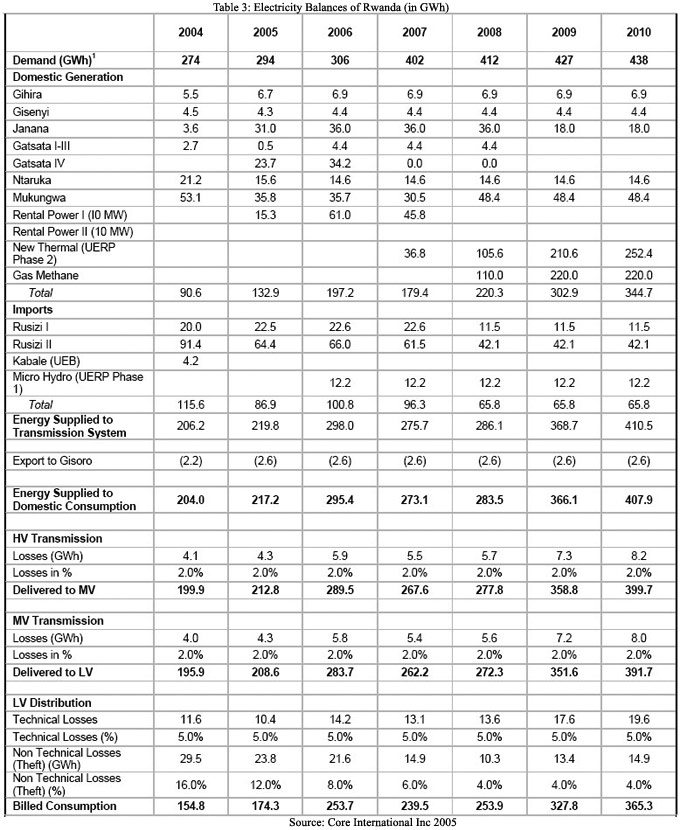
The hydrocarbon sub-sector
Rwanda is completely dependent on imported petroleum products. Hydrocarbons serve as a source of electricity by powering diesel generators, and are also used in the transport sector. About 42 per cent of the electricity produced in Rwanda is produced by diesel generators. Information on the petroleum sector is scanty and is therefore not included here.
Methane gas
One of the biggest inputs into the electricity grid in the near future will be power generated from methane gas extracted from the bottom of Lake Kivu. It is estimated to contain about 55 billion m3 of dissolved methane gas (MININFRA 2009b). Lake Kivu offers the best alternative for energy because of its relatively low construction cost and low estimated operating costs and is a key government priority.
The first efforts to utilise the methane deposits were undertaken in the late 1950s with 1.5 million cubic meters of gas being supplied annually to the nearby Balirwa Brewery in Gisenyi. The plant was shut down in 2004.
According to a rough estimate, the methane potential in the Lake is equivalent to 40 million tons oil equivalent, which means an estimated 700 MW can be produced by power plants continuously at least over a period of 55 years assuming an extraction rate of one billion cubic meters of methane per year (MININFRA 2009b).
Prior to current efforts to extract methane gas, extensive studies were conducted to evaluate potential environmental impacts and these included evaluation of leakage levels that would potentially contribute to global warming (MININFRA 2003). The results of the studies have guided the equipment design and other social and environmental management measures in the area.
Peat
Rwanda has peat reserves estimated at 155 million tonnes and therefore has the potential to replace wood, charcoal and fuel oil (MININFRA 2008b). It is estimated that about a third is commercially extractable and can be used for direct use as source of heat or for production of electricity. While power production from peat is still in a planning stage, the use of peat as burning fuel has already been tested in community institutions, for brick making and in the cottage industry (MININFRA 2009a). However the environmental impacts of commercial exploitation will need to be considered before peat can serve as a realistic energy alternative. Table 4 shows the development potential from the energy sources available in Rwanda.
Geothermal
Rwanda possesses geothermal resources in the form of hot springs along the belt of Lake Kivu with a power generation potential of about 170-320 MW. Preliminary technical exploration studies are currently being conducted.
Wind
The potential of wind as a source of energy is currently being investigated. A national wind atlas is going to be developed with the support of the Belgian Government.
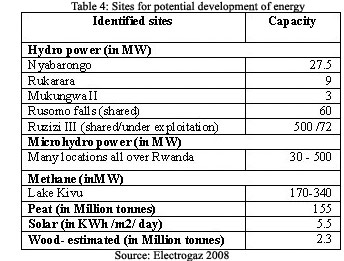
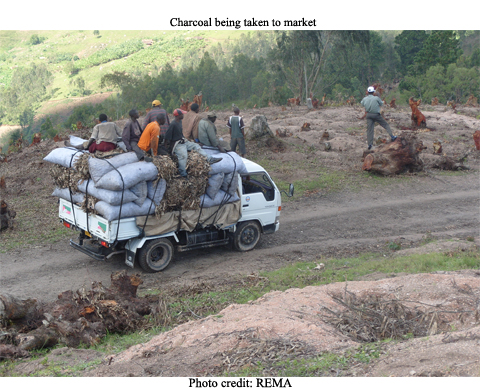
|
Opportunities provided by the energy sector
|
Reducing environmental impacts through improved energy supply
Energy consumption is intricately linked to environment and natural resources; and there are opportunities for improved environment management through more efficient energy use. The government recognizes the need for alternative, renewable energy sources, as a means of reducing tremendous pressure on woody biomass. Providing adequate, affordable energy is essential for eradicating poverty, improving human welfare, and raising living standards.
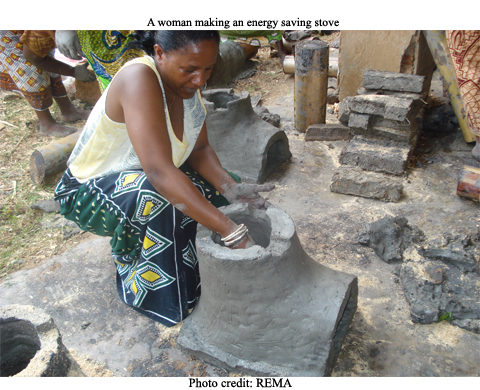
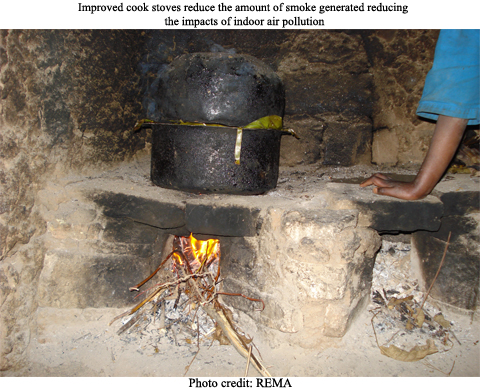
Transboundary power projects
The need for transboundary power projects is obvious in Rwanda because the country does not have enough capacity to produce electricity that can support the desired social and economic development. The nationally produced electricity has been found to be unsustainable due to seasonal variations in rainfall which sometimes result in low water levels and therefore reduced electricity generation. As already indicated Rwanda is importing electricity from SINELAC as a result of regional power partnerships with Burundi and the Democratic Republic of Congo, and from Uganda.
The government is committed to bridging this existing gap between demand and local production through the importation of electrical energy. With the emergence of the East African regional integration, there are opportunities for coordinated distribution of energy resources based on national energy balance. Table 6 .shows trends in national hydropower production with comparisons between imports and exports for 2006-2008.

Opportunity to enhance efficient utilization of energy
The recent energy strategic plan targets enhancing energy efficiency by reducing losses of technical nature from 23 to 15 per cent, and commercial losses from 12 to 5 per cent over the EDPRS period. Energy saving devices and appliances will also target to increase supply from 0 to 30 MW by the year 2012. Projects such as the rehabilitation of the transmission and distribution network, putting in place a system of investment and operational guidelines, conducting energy audit of the national power utility, distribution of 800,000 Compact Fluorescent Lamps (CFL) to households and commercial users will provide opportunities for enhanced efficiencies with real benefits for environmental protection.
|
Challenges faced by the energy sector
|
Energy efficiency in the transport sector
About 75 per cent of all imported petroleum is consumed within the transport sector; and transport costs are quite high. In Rwanda transport costs are estimated to be at least two and half times higher than in the neighboring countries (see table 7). The development of the sector, therefore, has both direct and indirect implications for the total energy consumption and socio-economic growth.
The energy challenge within the transport sector is to ensure efficient and safe use of petroleum products. Efficient petroleum use is determined by the standard of vehicles, the quality of the transport systems and the use of most energy efficient transport means. It is worth noting that all motor vehicles are imported and a majority of them are used cars which would otherwise need standard assessments to ascertain emission levels meet air quality standards. There is insufficient standardization and quality control of petroleum products and inadequate enforcement and uncoordinated safety measures. Data on transport emissions and resultant pollution effects is virtually absent except for a national inventory on greenhouse gases emissions carried out under the UNFCCC in 2002. This study indicated that the carbon-dioxide and methane gas emitted by petroleum products were 259.68 Gg and 0.042 Gg respectively. The carbon-dioxide emissions, mainly from the transport sector, are significant and these calls for more focused attention to ensure appropriate corrective measures are in place. The uncontrolled environmental pollution caused by vehicles is potentially dangerous especially in urban settlements like Kigali where the number of used cars are increasing at an extremely high rate.

Improving institutional capacity
Institutional coordination is still constrained by capacity limitations and knowledge gaps. For instance, there is not much awareness of the renewable energy alternatives and technology is very low in the country. Also the country is failing to benefit from the clean development mechanism because of a lack of knowledge on how to exploit the opportunities. There is also need for effective institutional coordination that promotes synergistic efforts towards a coherent national energy strategy particularly in favour of environmental protection.
The low consumption of commercial energy has had adverse impacts on economic growth, which is manifested in low levels of agricultural mechanization and industrialization. In the recent past Government has encouraged private sector in power generation. There is also need put in place effective strategies to build capacity, particularly for the private sector in conducting Environmental Impact Assessment (EIA). This has become evident with the development of the sector guidelines for environmental regulation which will, in all likelihood come with technical challenges to national environmental management.
|
Responses to improve the energy situation
|
Improving access to electricity
Access to electricity by 2006/7 was 4.7 per cent of the total population and is expected to grow up to 30 per cent in 2020. Per capita consumption of electricity is also expected to grow from 30kWh to 100kWh in 2020 (ROR 2007) as a result there is going to be a great demand in this sector. This increasing demand for modern energy has necessitated the search for alternative sources such as the micro-hydro potential and solar energy. The development of methane gas of Lake Kivu also represents a primary option because it could substitute traditional sources of energy, particularly the biomass-based wood and charcoal.
The EDPRS 2008-2012 forecasts that by 2012, 200,000 households are expected to have access to electricity compared with 70,000 now. This includes 300 administrative centres, 1000 schools and 180 health centres. The production capacity is planned to increase from 45MW to 130 MW by 2012 from 50MW excess power from hydro-electricity, 25MW of energy from methane gas power generation. ROR 2007 expects that from the year 2000 to 2020, the annual electricity consumption rate is going to increase from 30kWh to 100kWh. On the other hand, the EAESI (2005) estimates that the electricity access will rise from the current 4 to 35 per cent in 2020. It expects to achieve this by extending the grid to cover new settlements and through decentralizing generation using solar, hydropower or using diesel generators. When extending the grids priority will be given to services, markets, district headquarters, imudugudus, trading centres, factories, agro-processing facilities, health centres. Tables 8 and 9 show the hydro- and micro-hydro power projects that are planned or currently under construction.


Implementing the energy policy
The goal of National energy policy (ROR 2004) is to meet the energy challenges and needs of the Rwandan population for sustainable national development. Rwanda has already set forth energy policy options to develop the sector and at the same time to contribute to reduction of greenhouse gas emissions. These options aim especially to: increase access rate to modern energy resources such as hydropower, new and renewable energies; produce large quantity and quality of energy for urban and rural areas while improving security of electricity and petrol products supplies; and meet needs of domestic energy while protecting environment. The Ministry of Infrastructure has identified the priority policy actions as:
- Developing Lake Kivu methane and bringing on line more hydro power.
- Deliver a programme of rural electrification on the basis of enhanced distribution networks, micro hydro, and solar power.
- Implement a wood and charcoal efficiency and substitution strategy to counter the deforestation crisis.
- Specifically, with regards to rural policy, the Government of Rwanda has emphasized that the rural energy and electrification form an integral part of Rwanda’s overall rural transformation and poverty reduction strategy.
The National Energy Policy incorporates the MDGs in encouraging wider application of alternative energy sources for domestic and agricultural purposes, promoting small and medium-sized enterprises (SME), job creation, economic growth, decentralized power generations, promotion of efficient biogas conversion, improve use technologies, focusing on rural development through electrification of rural economic centres. It also focuses on the introduction of financial, legal and administrative institutions to develop appropriate rural energy system (EAESI 2005).
To achieve the set goals for sustainable development will require comprehensive policy reviews in support of environmentally friendly alternatives that include utilization of energy alternatives. The application of tools such as Strategic Environmental Assessment (SEA), the Environment Impact Assessment (EIA) as well as the operationalisation of legislative framework and other regulatory instruments all present opportunities for effective contribution of energy options towards poverty reduction and sustainable national economic growth.
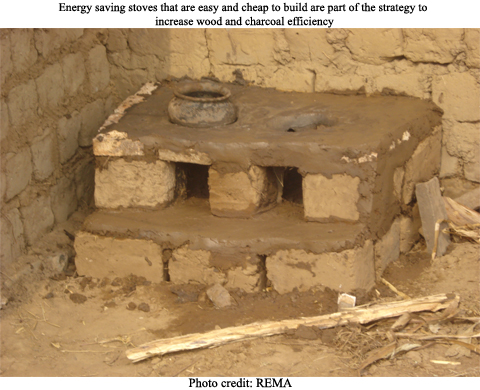
|
Conclusion and recommendations
|
The energy sub-sector plays a vital role in facilitating growth in other sectors such as agriculture, ICT, education and health; and in the provision of services in the public sector.
The government thus aims to ensure security of supplies by increasing production from several sources (hydro-electricity, methane gas, solar power, biomass and petroleum).
Other initiatives include improving cost-effectiveness and reflective tariffs as well as operational efficiency of the sector; increasing energy diversification and strengthening the governance framework and institutional capacity of the sub-sector. Some key recommendations are listed below:
- To establish a truly sustainable energy system Rwanda requires technological breakthroughs that radically alter how the country produces and uses energy. Institutional co-operation and co-ordination is imperative to achieve this goal.
- Regulatory measures for improvements in licensing, storage facilities and safety standards and pricing need to be addressed. Furthermore, it is necessary to improve mass transport systems to reduce fuel consumption, traffic congestion and pollution. The exploration for possibilities of fuel switch to other energy forms should be encouraged. The switch to unleaded fuel must be affected.
- The Energy and Agricultural Policy must be coordinated to promotion of environmentally friendly technologies and methods through collaboration with other ministries and institutions.
- There is a need to establish an institutional framework that can mobilize, co-ordinate and facilitate private and public initiatives for renewable energy/technologies usage in rural areas.
- It is necessary to create awareness and understanding of available renewable technologies, practices and resources.
- There is a need to promote efficient conversion and end-use energy technologies and practices in order to minimize health hazards primarily affecting women and children, and environmental degradation.
- Rural energy is diverse and characterized by various actors and interests. A sustainable institutional framework that can cope with the diversity, manage and co-ordinate various efforts, is a key factor for successful development of rural energy.
- Resolve the issue of fuel wood imbalance by a) planting of more trees, b) reducing demand for fuel wood in the domestic and institutional usage and maintenance of generation and transmission equipment by fully trained staff.
|
References
|
- Core International Inc (2005) Rwanda Electricity and Water Tariff Analysis, USAID. Available at http://www.globalregulatorynetwork.org/Files/PDFs/RwandaTariffReport.pdf
- Dekelver, G., Ruzigana, S. and J. Lam (2005). Report on the Feasibility Study for a Biogas Support Programme in the Republic of Rwanda. SNV and Ministry of Infrastructure (MININFRA), Kigali.
- EAESI (2005). Rwanda National Paper. Presented at the Forum of Energy Ministers for Africa (FEMA), East African Energy Scale Up Initiative (EAESI). Nairobi 24-2 June 2005. United Nations Development Programme (UNDP), Nairobi.
- Electrogaz (2008). Electrogaz 2007-2008 Annual reports. Electrogaz, Kigali.
- MININFRA (2003). The exploitation of Lake Kivu. Pilot Station Project. Lake Kivu Methane Project – Feasibility Study. Data Environment – June 2003. Pages 26 – 34. Ministry of Infrastructure (MININFRA), Kigali.
- MININFRA (2007) Operational, Financial and Administrative Guidelines. Manual_Procedures. Part 1. National Domestic Biogas Programme of Rwanda. Ministry of Infrastructure, (MININFRA), Kigali.
- MININFRA (2008a) Biomass Strategic Workshop, 30th April 2008. Ministry of Infrastructure (MININFRA), Kigali.
- MININFRA (2008b). Energy Sector Strategy, August 2008. Ministry of Infrastructure (MININFRA), Kigali.
- MININFRA (2009a). Electricity. MININFRA website. Ministry of Infrastructure (MININFRA), Kigali. Also available on: http://mininfra.gov.rw
- MININFRA (2009b). Hydrocarbons. MININFRA website. Ministry of Infrastructure (MININFRA), Kigali. Also available on: http://mininfra.gov.rw
- MININFRA (2009b). Hydrocarbons. MININFRA website. Ministry of Infrastructure (MININFRA), Kigali. Also available on: http://mininfra.gov.rw
- NBI (2007). Strategic/Sectoral, Social and Environmental Assessment of Power Development Options in the Nile Equatorial Lakes region. Final Report, Volume 1. Nile Basin Initiative (NBI), Kigali.
- Privatisation Secretariat (Undated). Energy and Water. Privatisation Secretariat, Ministry of Finance and Economic Planning (MINEFICON), Kigali.
- ROR (2000). Vision 2020. Ministry of Finance and Economic Planning, Republic of Rwanda (ROR), Kigali.
- ROR (2004). Energy Policy. Ministry of Infrastructure, Republic of Rwanda (ROR), Kigali.
- ROR (2007). Economic Development and Poverty Reduction Strategy 2008-2012. Ministry of Finance and Economic Planning, Republic of Rwanda (ROR), Kigali.
- Theuri, D., (2007). Energy Sector Costing to meet Rwanda’s Economic Development and Poverty Reduction Strategy (EDPRS) and the East Africa Community Regional Access to Modern Energy Services Strategy. United Nations Development Programme (UNDP)/United Nations Environment Programme (UNEP), Nairobi.
- UNDP (2007). Turning Vision 2020 into Reality: From Recovery to Sustainable Human Development. National Human Development Report, Rwanda 2007. United Nations Development Programme (UNDP), Kigali.
- Vanderplas (2004). Biomass Energy in Rwanda-An Update. Prepared for the PRSC. World Bank, Washington D.C.
- World Bank (2006). Rwanda Water Energy Assessment Note. Activity Completion Report Energy Sector Management Assistance Programme, Washington D.C. Also available on: http://wbln0018.worldbank.org/esmap/site.nsf/files/005-06+Rwanda+ACR.pdf/$FILE/005-06+Rwanda+ACR.pdf
|
|
|
|